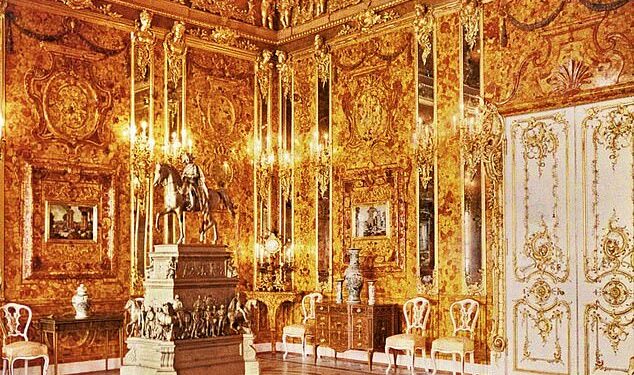An expert on the trail of lost Nazi treasures potentially worth billions believes he has found a cache of paintings hidden deep under the forests of Germany – but is being blocked from digging up the hoard by the local bureaucracy.
Buckhart List, 75 from Austria, is certain that the SS left a stockpile of stolen goods from a Hungarian Jewish art collector in a chamber some 100-140ft under a forest clearing near the village of Deutschkatharinenberg.
The journalist and author thinks the Nazis brought potentially 800 paintings – among them works by Monet, Cezanne and Pissaro – as well as gold and jewellery today ‘worth billions’ to chambers deep underground during the war.
A geophysical survey hopes to end the search after more than a decade of speculation, but Mr List now says the Saxony authorities have prevented him from going any further because a Stone Age tool was found about half a mile away, placing the area off-limits for archaeological digs.
In an appeal to continue his work, he told The Times: ‘I don’t want to take anything for myself. I know this belongs to people … who lost their lives.’

Archaeologists continue to search for the Amber Room, a trove of treasures thought to be worth hundreds of millions. Some say it was destroyed in the war, others hidden underground


French master: Cezanne’s La Chaine De E’toile Avec Le Pilon Du Roi, which is displayed in Glasgow and may have been looted by Nazis. More Cezannes are among the masterpieces thought to lie hidden in chambers under Germany
Mr List has been at the forefront of the search for the missing masterpieces of Baron Ferenc Hatvany in recent years, hoping to uncover hundreds of lost masterpieces.
He says that a survey by Professor Wolfgang Neubauer, director of the Ludwig Boltzmann Institute for Virtual Archaeology, in Austria, points to a chamber under a forest clearing in Germany.

Mr List has been leading a search for the missing art collection for over a decade
Dr Neubauer and a team helped make a breakthrough at Stonehenge using their imaging software in 2010.
The theory goes that a mine near Deutschneudorf was sealed with an explosion to keep away those on the brink of uncovering Nazi treasure troves – and evidence of hidden Jewish gold.
Mr List, who launched his expedition more than a decade ago, believes the hidden cache could house ‘billions’ worth of art, gold and jewellery pilfered from Budapest during the 1944 occupation.
Now, the challenge is cut through the red tape.
Mr List says that he is appealing a ban on excavation imposed by local authorities after the discovery of a Stone Age tool nearby.
He believes the chamber may contain the missing masterpieces of Baron Hatvany, a Jewish Hungarian art collector whose collection was stolen during the war.
Many of his treasures were carted off from Budapest bank vaults by Red Army soldiers when the city fell to the Soviets in 1945.
But most of the Hatvany Collection, between 250 and 500 pieces, was looted on the orders of Holocaust organiser Adolf Eichmann, who was in Hungary in 1944 and instituted a policy of arresting Jews and then releasing them in exchange for property – or sending them to Auschwitz.
Mr List said some 12 years ago that he had acquired documents from old Wehrmacht archives that report a mass shipment of the Hatvany collection to two subterranean galleries, measuring 6,000 by 4,500 feet, in the Erzgebirge Mountains.
With the permission of the mayor of nearby Deutschkatherinenberg, Hans-Peter Haustein, he deployed a neutron generator inside the mountain to probe for the secret chambers.
The device revealed that, 180 feet down, there are workings not detailed on maps, and they appear to be man-made, not natural.
Mr List said: ‘In the winter of 1944 – 1945 the records indicate that a mysterious transport arrived here from Budapest that was coded top secret.
‘One of the photos yielded up by the archives was of the Sonnenhaus, a large building directly in front of the Fortuna mine where I believe the art is stored.
‘It shows a large contingent of SS. There was no military or logical state purpose for them to be here on a secret mission, unless it was to deliver the artwork into chambers which, climactically, are ideal for the storage of art.’
Early explorations revealed only a Schmeisser machine gun, a Nazi gas mask, plastic explosive detonators and a safe deposit key.
Mayor Haustein, who is also an MP for the FDP liberal party in Berlin, said at the time: ‘The question is not what we find here, but when we find it.
‘I have seen the evidence and I have heard the testimony of eyewitnesses over the years about the presence of the SS in the village. This stuff is here.’
The Sonnenhaus is already drawing visitors ahead of a planned May descent into the mountain that will attempt to open up the secret chambers accessed so far only by radar.
Mr List’s is not the first application to be turned down in the search for Nazi gold, however.
Five applications a year are also made to the Thuringian state archaeological office and other bodies to try to dig for the Amber Room, a coveted trove of gold and amber worth hundreds of millions in today’s money.
All had been turned down until 2017, when the state conceded permission with the local forestry association. The dig, evidently, did not uncover the Amber Room.
The search for the room, a jewel-studded chamber built in the 18th century, has taken archaeologists everywhere from sunken ships dives off the coast of Poland to secret forest tunnels in central Europe and excavations of sites used to built the V1 and V2 rockets.
The accepted theory is that it was destroyed by Russian artillery fire when the Red Army stormed the city in 1945. However, there are people who claim it was spirited away before the fall.

A recreation of the Amber Room pictured at the Catherine Palace in Russia in 2008

A Nazi diary, written by SS officer Egon Ollenhauer, claims Adolf Hitler ordered 260 trucks laden with gold, looted treasure and valuables to be hidden in 11 locations in Poland

Treasure hunters were recently warned to avoid a former Nazi concentration camp after a documentary claimed Hitler ordered stolen treasure to be buried in tunnels at the site

Camp inmates pointed US soldiers towards a tunnel containing 21 tonnes of gold – much of it in the form of gold teeth and rings taken from Jewish victims of the Holocaust
The room was originally presented to Peter the Great by the King of Prussia.
Later, Catherine the Great commissioned a new generation of craftsmen to embellish the room and moved it from the Winter Palace in St Petersburg to her new summer abode in Tsarskoye Selo, outside the city.
‘When the work was finished, in 1770, the room was dazzling,’ wrote the art historians Konstantin Akinsha and Grigorii Kozlov.
‘It was illuminated by 565 candles whose light was reflected in the warm gold surface of the amber and sparkled in the mirrors, gilt, and mosaics.’
The Germans much later took the room to Königsberg, the capital of East Prussia, which is now the Russian enclave of Kaliningrad.
After the war, the Amber Room became central Europe’s El Dorado, a quest that enthralled the wealthy and the poor alike.
Crafted entirely out of amber, gold and precious stones the Amber Room was a masterpiece of baroque art and widely regarded as the world’s most important art treasure.







